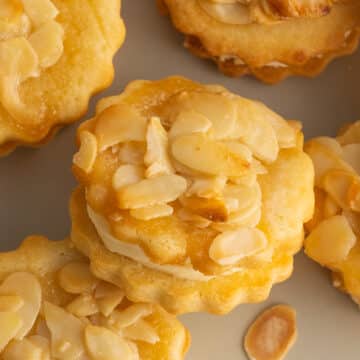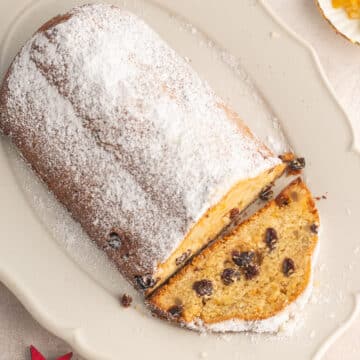A typical baklava recipe with step-by-step instructions is my bring-back from a former vacation. Because my passion for baking doesn't let me go, of course, even when I travel. Everywhere I look for regional specialties, I look in bakeries and try to elicit tips from local bakers 😉 . Like when we were in Cyprus for a week. With this recipe, you will find that making baklava itself is not even soo complicated!
Taste and Occasion
Fortunately, at that time, I asked the bakers and pastry chefs in our hotel if I could accompany them at work. Because so, I was there when preparing the baklava recipe. The sugary sweet treat made of dough sheets and syrup is very popular in many countries of the Arabian world as well as in Greece and Turkey, among others.
I call it an original baklava recipe, because it comes from a region of origin. After all, according to my research, there is no single original, but only special alternatives from different countries (even if that might be seen a little differently in Turkey).

Ingredients
You need filo dough and a nut filling, be it hazelnuts, walnuts, or pistachios; A note: making baklava yourself takes some time. But the effort is worth it! High-quality filo dough or yufka dough is essential for good taste. If you buy filo dough, make sure it doesn't look too dry.
One baklava recipe, many alternatives, one preparation method: You make some out of yufka dough or filo dough, and some out of puff pastry. The filling may contain, for example, pistachios (for Turkish), almonds, walnuts, honey, lemon juice, cinnamon (Greek), and rose water. In any baklava recipe, the preparation is similar in numerous steps: layer many thin sheets of dough on top of each other, on a foundation layer comes the filling, and the conclusion is again dough sheets. After baking, homemade baklava is soaked with a lot of syrup. Sugar or honey in masses!

How to make the Baklava
First of all, grind or finely chop the nuts or almonds coarsely. Mix with the cinnamon and set aside. Melt the ghee or butter. Preheat the oven to 320°F/160°C. Weigh out 200 g of filo leaves. On the bottom of an ovenproof dish (about 10*14 in / 25*35 cm), first place two layers of filo sheets (so that the entire bottom is covered with a double layer of filo). Brush with a lot of liquid ghee or butter, put two layers of sheets again, brush them with liquid ghee and continue until the 200 g are used up.
Then, spread the nut mixture on top. Do the same with the remaining 300 g filo dough until all the dough and fat are used up: Put 2 layers of dough in each mold, spread with ghee, and so on. Finally, brush the surface with ghee. The fat should be used up entirely, after baking, pour off the excess fat. Pre-draw lines with a large knife, so you do not cut curves when cutting each baklava diamond or square… Use a smaller sharp knife to carefully cut pieces.
Now, spray the finished prepared baklava with a bit of cold water to prevent the dough from rising too much and to crisp the surface. Bake baklava at 320°F/160°C for about 30 to 40 minutes until golden brown. Note: depending on the stove, it may take shorter or longer!
Meanwhile, prepare the sugar syrup: In a saucepan, combine sugar and water, boil, let dissolve, and reduce over low heat for about 5 to 10 minutes. Stir in lemon juice and optionally add rose water. When the baklava is done, you can "dump" excess ghee; to do this, hold the baking pan or baking sheet at an angle over the spout with oven mitts. Then pour the hot syrup over the baklava while it is still hot. Allow infusing and cooling. Separate the pre-cut pieces again with a knife. Enjoy!

Top Tip
Baklava is definitely a sumptuous dessert, but also a very delicious one. If you like it a little less sweet, you can definitely reduce the amount of sugar syrup without significant losses 😉.

Recipe Card

Traditional Baklava
Ingredients
For dough and filling
- 500 grams (2 cups) filo dough sheets, you can buy them in a Turkish store or similar
- 200 grams (1 ⅖ cups) nuts, finely chopped or coarsely ground
- 1 teaspoon cinnamon
- 200 grams (1 cup) ghee, alternatively butter
For the syrup
- 200 milliliters (⅘ cups) water
- 300 grams (1 ½ cups) sugar
- 1 teaspoon lemon juice
- 20 milliliters (1 ⅖ tablespoons) rose water, optional
Instructions
- Coarsely grind or finely chop the nuts or almonds. Mix with the cinnamon and set aside. Melt the ghee or butter. Preheat the oven to 320°F/160°C.
- Weigh out 200 g of filo leaves. On the bottom of an ovenproof dish (about 1014 in/ 2535 cm), first place two layers of filo sheets (so that the entire bottom is covered with a double layer of filo). Brush with a lot of liquid ghee or butter, put two layers of sheets again, brush them with liquid ghee and continue until the 200 g are used up.
- Then spread the nut mixture on top. Do the same with the remaining 300 g filo dough until all the dough and fat are used up: Put 2 layers of dough in each mold, spread with ghee, and so on. Finally, brush the surface with ghee. The fat should be used up entirely, after baking, pour off the excess fat.
- Pre-draw lines with a large knife, so you do not cut curves when cutting each baklava diamond or square… Use a smaller sharp knife to carefully cut pieces.
- Spray the finished prepared baklava with a bit of cold water to prevent the dough from rising too much and to crisp the surface.
- Bake baklava at 320°F/160°C for about 30 to 40 minutes until golden brown. Note: depending on the stove, it may take shorter or longer!
- Meanwhile, prepare the sugar syrup: In a saucepan, combine sugar and water, boil, let dissolve, and reduce over low heat for about 5 to 10 minutes. Stir in lemon juice and optionally add rose water.
- When the baklava is done, you can "dump" excess ghee; to do this, hold the baking pan or baking sheet at an angle over the spout with oven mitts. Then pour the hot syrup over the baklava while it is still hot. Allow infusing and cooling. Separate the pre-cut pieces again with a knife.
Ingredient substitutions
Variations
Those who want to bake vegan baklava can also take vegan fat instead of ghee or butter. (The fat, by the way, does not remain entirely in the pastry.) The huge quantities from the restaurant kitchen, I have, of course, measured down to a normal baklava amount for you. If you take a small baking sheet or similar, this should have a high edge. And now, have fun baking the recipe!







Comments
No Comments